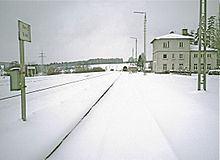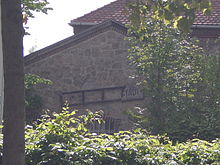Kirchenlamitz – Weißenstadt railway line
| Kirchenlamitz Ost – Weißenstadt | |||||||||||||||||||||||||||||||||||||||||
|---|---|---|---|---|---|---|---|---|---|---|---|---|---|---|---|---|---|---|---|---|---|---|---|---|---|---|---|---|---|---|---|---|---|---|---|---|---|---|---|---|---|
|
Former Weissenstadt train station
| |||||||||||||||||||||||||||||||||||||||||
| Route number (DB) : | 5035 | ||||||||||||||||||||||||||||||||||||||||
| Course book range : | last 425p | ||||||||||||||||||||||||||||||||||||||||
| Route length: | 13.5 km | ||||||||||||||||||||||||||||||||||||||||
| Gauge : | 1435 mm ( standard gauge ) | ||||||||||||||||||||||||||||||||||||||||
| Maximum slope : | 25 ‰ | ||||||||||||||||||||||||||||||||||||||||
| Minimum radius : | 200 m | ||||||||||||||||||||||||||||||||||||||||
| Top speed: | 60 km / h | ||||||||||||||||||||||||||||||||||||||||
|
|||||||||||||||||||||||||||||||||||||||||
The Kirchenlamitz – Weißenstadt railway line was a branch line in Bavaria . It was opened on July 20, 1899 as a local railway line by the Bavarian State Railway and was one of the seven railway lines that previously opened up the Fichtel Mountains .
history
On August 15, 1877, the Oberkotzau - Holenbrunn section of the Fichtelgebirgsbahn , which led the line past the cities of Wunsiedel and Weißenstadt , was opened. About ten years later, Weißenstadt wanted its own rail connection in order to be able to better transport the granite blocks extracted from Epprechtstein and processed in the city . Up until now, oxen had to transport the blocks to the nearest station in Falls , where they were loaded onto the Ludwig-Süd-Nord-Bahn .
When the proposal of the Weißenstädter became known, various cities joined that wanted to lead the route over their terrain. Wunsiedel had fallen behind since the opening of the last section of the Fichtelgebirgsbahn between Marktredwitz and Holenbrunn and advocated a railway line directly to Weißenstadt. A route over the nearby town of Röslau would have been acceptable for the Wunsiedlers, but a second variant soon emerged, leading the railway via Kirchenlamitz to Weißenstadt. Although the village had owned the Kirchenlamitz Ost train station for four years, it was four kilometers outside the village and was rarely used by the residents. The industrialists Georg Ackermann from Weißenstadt and Frank Grimm from Kirchenlamitz advocated the Kirchenlamitz variant. The former mayor of Weißenstadt Karl Schmidt and the factory owner Kleemann, who were joined by the banker Schmidt (founder of the Schmidt Bank ) and the senior government councilor Hallmeyer, were in favor of this route. The secondary school teacher Georg Heim advocated the variant via Röslau, who represented Wunsiedel's interests with sometimes rather flimsy arguments. He explained that if the route were to be relocated via Kirchenlamitz, the Weissenstadt Catholics (at that time five in number) would come too late to the service in Wunsiedel. Only when the general director of the state railway, von Ebermayer, had made his own picture of the situation, did he come to the conclusion that the granite blocks from Epprechtstein, which made up the majority of the transported goods, would be easier to load on a route via Kirchenlamitz than with the other variant. After reviewing the feasibility of the project, it was approved by the Local Railway Committee on February 21, 1896. The expenses for the construction of the line were put at 764,600 marks . The railway was finally included in the Bavarian Local Railway Act together with the Münchberg – Helmbrechts line, which was celebrated both in Weißenstadt and in Kirchenlamitz with separate sheets of the local newspapers and various festive events.
After the disputes between the cities were over, surveying work began in 1897 for the new Weißenstadt-Kirchenlamitz railway line. Construction began a year later and the completion of the route was celebrated on April 28, 1899, before it was inaugurated on July 20. In 1920 there were first expansion plans for the railway. A continuation of the line to Gefrees was planned, where the two lines Weißenstadt – Kirchenlamitz and Falls – Gefrees were to unite. However, nothing came of these plans any more than of the efforts to connect Zell and Weißenstadt with one another.
In over 60 years of operation there were hardly any noticeable disruptions to rail traffic on the line, except for the shutdown of rail traffic in the winter months of 1918, 1924, 1942–1943 and 1945. Various smaller accidents mostly went without any significant damage. In the winters, more and more winter sports trains ran on the route that brought athletes from Hof to the Epprechtstein region.
In 1960 the railway had a count of the train passengers carried out at the Niederlamitz stop . Such actions were mostly heralds for a shutdown of operations (see Münchberg – Zell railway line ). In Niederlamitz, too, the conclusion was reached that the maintenance of the stop, as well as the entire route, was unprofitable - they considered shifting all traffic to rail buses . The population owed it to two heads of the Federal Railway Directorate in Regensburg that the route continued to be served: The profitability of the railway was to be increased through the use of diesel locomotives . Two years later, the Buchhaus stop was no longer served, which was met with bitter criticism from local companies, as the Epprechtstein stop required for the transport of granite had already been closed. In the same year it also hit the Kleinschloppen stop . The complaint from the chairman of the Raiffeisenkasse did nothing to change the closure, although the till was one of the most important customers of the railway with the transport of fertilizers .
In 1982 the freight traffic that had been maintained after the cessation of passenger traffic ended there. One year after the closure on December 31, 1993, the track dismantling began. The abolition of the Kirchenlamitz – Weißenstadt line meant the end of rail traffic in the Waldstein and Epprechtstein area .
Route and buildings
The starting station of the line was in the village of Niederlamitzenhammer. There is still the imposing station building, which has not been maintained by the railway since 2004 and is now used privately. Of the once four main tracks and a total of eight secondary connections with their own turntable , only the two through tracks have been preserved. The Kirchenlamitz stop is just under 500 meters away. The toilet facilities were like accommodated on most secondary routes in a separate cottage, but were moved to its demolition in the 50s in the railway station. The freight hall of the station lost its function in 1973, but was retained, as was the post office located nearby . The building of the former railway maintenance office with the fresh water tank for the locomotives on the upper floor and one of the two track keeper's houses still exist, unlike the railway maintenance depot , which fell victim to the pickaxe after it was closed. The station's two signal boxes no longer exist either. From Kirchenlamitz Ost, the train first reached the Niederlamitz stop, which had just one platform. Up to this point the route crossed two simple bridges. A special feature was the arch bridge made of granite over Hofer Strasse in Kirchenlamitz. It has since been canceled.
3.67 kilometers after leaving Kirchenlamitz Ost, the train reached Kirchenlamitz Stadt station. The granite station building with attached loading hall is privately owned. In the station itself there were connections to the loading areas of the two granite companies Reul and Grimm, as well as a private track from Winterling-Porzellan . The two companies Wächter and Hallmeyer, whose founders had campaigned for the construction of the line at the time, also had private connections. In addition to the main building, the wooden goods shed was also preserved. The distance rose 58 meters. This difference in height had to be overcome by a curve with a radius of 200 meters. To prevent the wagons from breaking out, an additional compulsory rail was installed to keep the wagons on track. Shortly after this bend the train passed the Epprechtstein loading area. The former loading ramps are only faintly visible. One of them had another rail connection, there ended a run by wire ropes Lorenbahn from nearby Chateau Spring break. Until the Second World War it was used to transport the granite stones to the railway station.
Behind Buchhaus was the highest point of the Upper Franconian route network at 660 meters . The route led over several bridges and a creek in the railway embankment to the Kleinschloppen stop with its own agency building , which is still available in a modified form. After 12 kilometers, the terminus in Weißenstadt was reached. This was followed by an approx. 1.4 km long industrial track.
This wing track crossed several streets and served the Grasyma granite works , the timber loading area, a warehouse and a sawmill. In Weißenstadt itself there was the engine shed next to the station building . Three private sidings branched off from the main route there. The former freight hall attached to the station building has disappeared. In their place there is a warehouse.
Vehicle use
For the longest time, a train set consisting of a PWL (PackWagen für Lokalbahnen) bay. 06, a baggage cart, a CL bay. 06, a CL bay. 06b, a freight car GmP (Güterwagen mit Post) and a post car CPostL.
The first locomotive to be used as scheduled on the line was a type D XI . Later, two brand-new machines from the Maffei locomotive factory came on the line, which ran there until 1923. This was followed by the class D VIII , which was stationed in Weißenstadt until the standard locomotives were purchased . During this time, machines of the types R 3/3 , GtL 4/4 and GtL 4/5 were also used instead . Types from the 70 series probably also ran on the route. The locomotives that shaped the railway the longest were series 64 and 86 machines . They were on the route until July 8, 1967, and were replaced by class V 100 diesel locomotives . At the same time, units from the V 60 series were also used. As with almost all branch lines in the Fichtelgebirge, a VT 95 multiple unit formed the end .
literature
- Harald Enes: The Bockel. Portrait of a local train. The Kirchenlamitz Ost – Weißenstadt railway line. Printer and publishing house Heinz Späthling, Weißenstadt 2008, ISBN 978-3-926621-66-5 .
- Wolfgang Bleiweis, Ekkehard Martin, Stefan Winkler: Franconian branch lines then and now . Bufe-Fachbuchverlag, Egglham 1987, ISBN 3-922138-30-6 .
- Kerstin Schäfer: The high-rise buildings of the Upper Franconian branch lines. History, inventory and conversion. Eisenbahn-Fachbuch-Verlag, 2013, ISBN 978-3-944237-05-3 .
- Bernd Schmitt and Gerald Hoch: branch lines in Upper Franconia . 1st edition. Michael Resch, Coburg 1999, ISBN 3-9805967-4-5 , p. 182 ff .
Web links
Individual evidence
- ↑ Harald Enes: The Bockel. The Kirchenlamitz Ost - Weißenstadt railway line , p. 23.
- ↑ Harald Enes: The Bockel. The Kirchenlamitz Ost - Weißenstadt railway line , p. 25
- ↑ Harald Enes: The Bockel. The Kirchenlamitz Ost - Weißenstadt railway line , p. 24
- ↑ Harald Enes: The Bockel. The Kirchenlamitz Ost - Weißenstadt railway line , p. 27
- ↑ Harald Enes: The Bockel. The Kirchenlamitz Ost - Weißenstadt railway line , p. 110
- ↑ Harald Enes: The Bockel. The Kirchenlamitz Ost - Weißenstadt railway line , p. 86f
- ↑ Harald Enes: The Bockel. The Kirchenlamitz Ost - Weißenstadt railway line , p. 87
- ↑ Harald Enes: The Bockel. The Kirchenlamitz Ost - Weißenstadt railway line , pp. 29–37
- ↑ Harald Enes: The Bockel. The Kirchenlamitz Ost - Weißenstadt railway line , pp. 44–48
- ↑ Bernd Schmitt and Gerald Hoch: Branch lines in Upper Franconia . 1st edition. Michael Resch, Coburg 1999, ISBN 3-9805967-4-5 , p. 182 .
- ↑ Harald Enes: The Bockel. The Kirchenlamitz Ost - Weißenstadt railway line , pp. 53–59
- ↑ Harald Enes: The Bockel. The Kirchenlamitz Ost - Weißenstadt railway line , p. 60
- ↑ Harald Enes: The Bockel. The Kirchenlamitz Ost - Weißenstadt railway line , pp. 91–107















